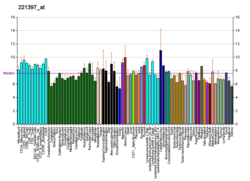TAS2R10
Taste receptor type 2 member 10 is a protein that in humans is encoded by the TAS2R10 gene.[5][6][7]
Function
This gene product belongs to the family of candidate taste receptors that are members of the G-protein-coupled receptor superfamily. These proteins are specifically expressed in the taste receptor cells of the tongue and palate epithelia. They are organized in the genome in clusters and are genetically linked to loci that influence bitter perception in mice and humans. In functional expression studies, they respond to bitter tastants. This gene maps to the taste receptor gene cluster on chromosome 12p13.[7]
TAS2R10 is also expressed in the smooth muscle of human airways, along with several other bitter taste receptors. Their activation in these cells causes an increase in intracellular calcium ion, which in turn triggers the opening of potassium channels which hyperpolarize the membrane and cause the smooth muscle to relax. Hence, activation of these receptors leads to bronchodilation.[8]
See also
References
- ENSG00000121318, ENSG00000277238 GRCh38: Ensembl release 89: ENSG00000272805, ENSG00000121318, ENSG00000277238 - Ensembl, May 2017
- GRCm38: Ensembl release 89: ENSMUSG00000063478 - Ensembl, May 2017
- "Human PubMed Reference:". National Center for Biotechnology Information, U.S. National Library of Medicine.
- "Mouse PubMed Reference:". National Center for Biotechnology Information, U.S. National Library of Medicine.
- Adler E, Hoon MA, Mueller KL, Chandrashekar J, Ryba NJ, Zuker CS (Apr 2000). "A novel family of mammalian taste receptors". Cell. 100 (6): 693–702. doi:10.1016/S0092-8674(00)80705-9. PMID 10761934.
- Matsunami H, Montmayeur JP, Buck LB (Apr 2000). "A family of candidate taste receptors in human and mouse". Nature. 404 (6778): 601–4. doi:10.1038/35007072. PMID 10766242.
- "Entrez Gene: TAS2R10 taste receptor, type 2, member 10".
- Deshpande DA, Wang WC, McIlmoyle EL, Robinett KS, Schillinger RM, An SS, Sham JS, Liggett SB (November 2010). "Bitter taste receptors on airway smooth muscle bronchodilate by localized calcium signaling and reverse obstruction". Nat. Med. 16 (11): 1299–304. doi:10.1038/nm.2237. PMC 3066567. PMID 20972434.
Further reading
- Kinnamon SC (2000). "A plethora of taste receptors". Neuron. 25 (3): 507–10. doi:10.1016/S0896-6273(00)81054-5. PMID 10774719.
- Margolskee RF (2002). "Molecular mechanisms of bitter and sweet taste transduction". J. Biol. Chem. 277 (1): 1–4. doi:10.1074/jbc.R100054200. PMID 11696554.
- Montmayeur JP, Matsunami H (2002). "Receptors for bitter and sweet taste". Curr. Opin. Neurobiol. 12 (4): 366–71. doi:10.1016/S0959-4388(02)00345-8. PMID 12139982.
- Chandrashekar J, Mueller KL, Hoon MA, Adler E, Feng L, Guo W, Zuker CS, Ryba NJ (2000). "T2Rs function as bitter taste receptors". Cell. 100 (6): 703–11. doi:10.1016/S0092-8674(00)80706-0. PMID 10761935.
- Zhang Y, Hoon MA, Chandrashekar J, Mueller KL, Cook B, Wu D, Zuker CS, Ryba NJ (2003). "Coding of sweet, bitter, and umami tastes: different receptor cells sharing similar signaling pathways". Cell. 112 (3): 293–301. doi:10.1016/S0092-8674(03)00071-0. PMID 12581520.
- Fischer A, Gilad Y, Man O, Pääbo S (2005). "Evolution of bitter taste receptors in humans and apes". Mol. Biol. Evol. 22 (3): 432–6. doi:10.1093/molbev/msi027. PMID 15496549.
- Go Y, Satta Y, Takenaka O, Takahata N (2006). "Lineage-Specific Loss of Function of Bitter Taste Receptor Genes in Humans and Nonhuman Primates". Genetics. 170 (1): 313–26. doi:10.1534/genetics.104.037523. PMC 1449719. PMID 15744053.
- Mueller KL, Hoon MA, Erlenbach I, Chandrashekar J, Zuker CS, Ryba NJ (2005). "The receptors and coding logic for bitter taste". Nature. 434 (7030): 225–9. doi:10.1038/nature03352. PMID 15759003.
This article incorporates text from the United States National Library of Medicine, which is in the public domain.




